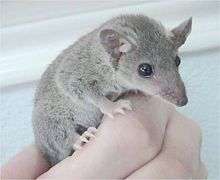Short-tailed opossum
| Short-tailed opossums | |
|---|---|
 | |
| Gray short-tailed opossum Monodelphis domestica | |
| Scientific classification | |
| Kingdom: | Animalia |
| Phylum: | Chordata |
| Class: | Mammalia |
| Infraclass: | Marsupialia |
| Order: | Didelphimorphia |
| Family: | Didelphidae |
| Subfamily: | Didelphinae |
| Genus: | Monodelphis Burnett, 1830 |
| Type species | |
| Monodelphis brachyura Burnett, 1830 | |
| Species | |
|
see text | |
Monodelphis is a genus of marsupials in the family Didelphidae, commonly referred to as short-tailed opossums. They are found throughout South America. The most recently described species are Monodelphis arlindoi Pavan, Rossi & Schneider, 2012, Monodelphis sanctaerosae Voss, Pine & Solari, 2012 and Monodelphis gardneri Solari et al., 2012, with reinstatement of Monodelphis touan (Shaw, 1800), and Monodelphis pinocchio Pavan, 2015.
Species
- Sepia short-tailed opossum (Monodelphis adusta)
- Northern three-striped opossum (Monodelphis americana)
- Northern red-sided opossum (Monodelphis brevicaudata)
- Yellow-sided opossum (Monodelphis dimidiata)
- Gray short-tailed opossum (Monodelphis domestica)
- Emilia's short-tailed opossum (Monodelphis emiliae)
- Amazonian red-sided opossum (Monodelphis glirina)
- Ihering's three-striped opossum (Monodelphis iheringi)
- Pygmy short-tailed opossum (Monodelphis kunsi)
- Marajó short-tailed opossum (Monodelphis maraxina)
- Osgood's short-tailed opossum (Monodelphis osgoodi)
- Hooded red-sided opossum (Monodelphis palliolata)
- Reig's opossum (Monodelphis reigi)
- Ronald's opossum (Monodelphis ronaldi)
- Chestnut-striped opossum (Monodelphis rubida)
- Long-nosed short-tailed opossum (Monodelphis scalops)
- Southern red-sided opossum (Monodelphis sorex)
- Southern three-striped opossum (Monodelphis theresa)
- Red three-striped opossum (Monodelphis umbristriata)
- One-striped opossum (Monodelphis unistriata)
- Monodelphis pinocchio
Speciation is based on fur coloration with additional details coming from differences in the skull and teeth. [1]
Conservation status
M. sorex and M. rubida are considered to be endangered. M. dimidiata is unusual in that it is a semelparous species, something rarely seen in mammals (found predominately in smaller didelphids and dasyurids).
Reproductive Development
The genus Monodelphis is marsupial; they are born under-developed and then mature further in the mother's pouch. Another genus in the subfamily is the large American opossum Didelphis, which has a generally similar reproductive development, but differs in their weaning periods. In Monodelphis, the young first come off the teat in 12 days, whereas this occurs at 48 days in Didelphis. Most of the events in this process occur about 2-4 weeks later in Didelphis than in Monodelphis. This may be related to the shorter longevity of the species of Monodelphis compared to other marsupials who nurse for a longer period.[2]
References
- ↑ Solari, Sergio. A Molecular Perspective on the Diversification of Short-Tailed Opossums (Monodelphis: Didelphidae). Mastozoología Neotropica 17.2 (2010): 317-33. Scientific Electronic Library Online.
- ↑ Smith, K.K., "Comparative Rates of Development in Monodelphis and Didelphis”, Science, 31 January 1997: 275 no. 5300 pp. 683-684 DOI: 10.1126/science.275.5300.683.
- CASTILHEIRO, Welvis Felipe Fernandes and SANTOS FILHO, Manoel dos. Diet of Monodelphis glirina (Mammalia: Didelphidae) in forest fragments in southern Amazon. Zoologia (Curitiba) [online]. 2013, vol.30, n.3 [cited 2016-10-12], pp.249-254. Available from: <http://www.scielo.br/scielo.php?script=sci_arttext&pid=S1984-46702013000300001&lng=en&nrm=iso>. ISSN 1984-4670. http://dx.doi.org/10.1590/S1984-46702013000300001.
- Know Your Short-tailed Opossum: Monodelphis
- Integrated Taxonomic Information System
- Gardner, A.L. (2005). "Order Didelphimorphia". In Wilson, D.E.; Reeder, D.M. Mammal Species of the World: A Taxonomic and Geographic Reference (3rd ed.). Johns Hopkins University Press. pp. 13–16. ISBN 978-0-8018-8221-0. OCLC 62265494.
External links
 Data related to Monodelphis at Wikispecies
Data related to Monodelphis at Wikispecies